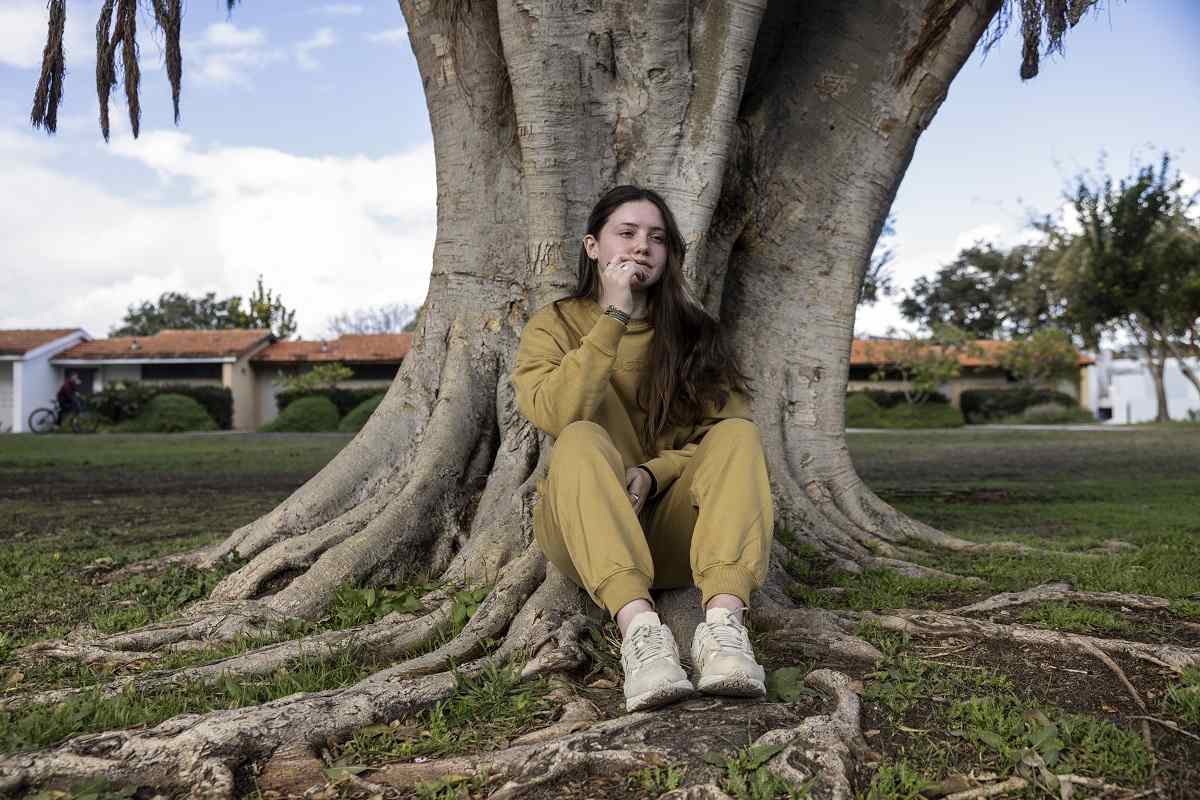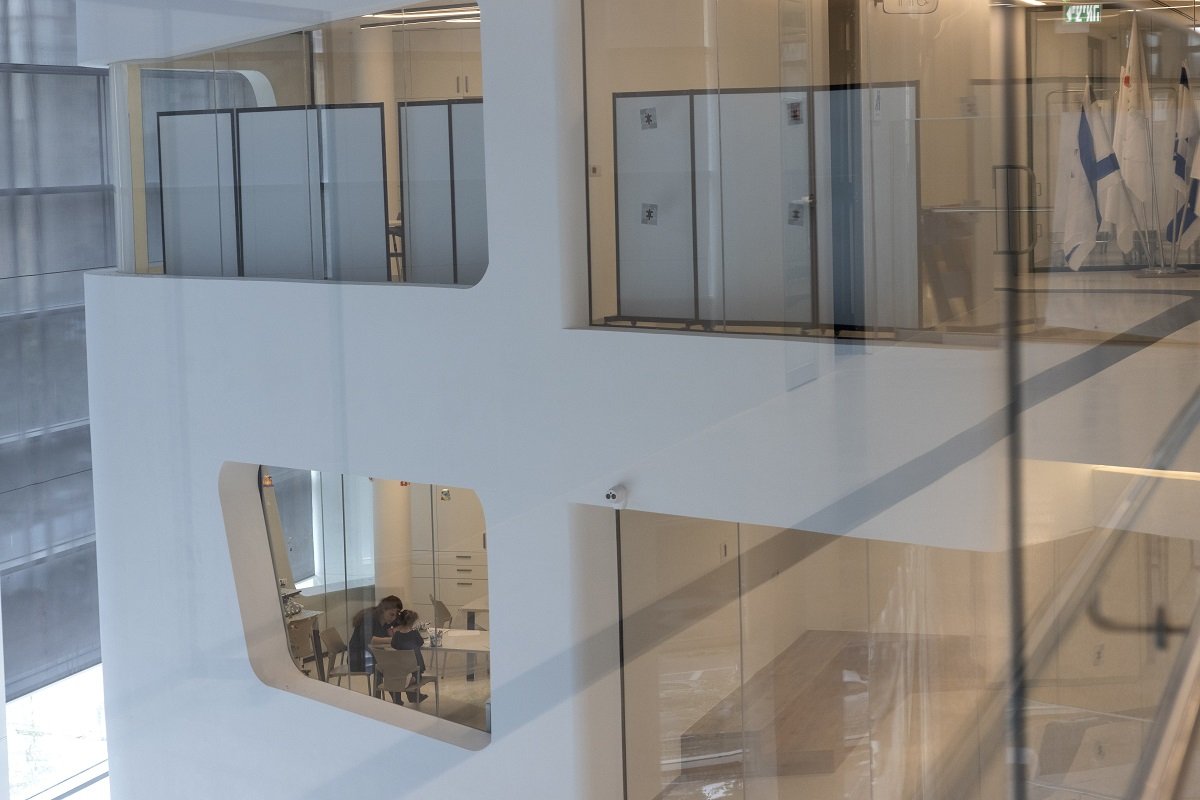
Agam Goldstein Almog was kidnapped from her home at Kibbutz Kfar Aza in southern Israel during the Hamas-led attack on Oct. 7.
12:04 JST, January 16, 2024
SHFAYIM, Israel – As soon as Hamas gunmen abducted Agam Goldstein-Almog, 17, from her home in Kibbutz Kfar Aza on Oct. 7, they worked to dismantle her identity.
They shuffled her between subterranean tunnels, abandoned apartments and a school that doubled as a rocket launching site, she said, covering her in a headscarf and a long dress and commanding her to look at the ground. She said they ordered her to recite Islamic prayers and renamed her Salsabil, the natural springs of paradise mentioned in the Quran. They allowed her to shower five times in 51 days, she said.
“They took me, what remained of my family and it felt like, ‘That’s it, now we are living in Gaza,'” she told The Washington Post. “And that’s why it felt like it would be forever.”
Agam said she was forbidden from crying. She was not to mourn her father and older sister, 20-year-old Yam, shot dead by militants in their family home. Sometimes the captors shouted at her, she remembered, other times they tried to win her sympathy with looted creams and perfumes.
With guns cocked, Agam said they warned her family – especially her 9- and 11-year-old brothers – against making noise. If Israel found out where they were hiding, she remembers the kidnappers saying, the military would kill them all.
It was one of countless lies they told to assert “absolute control,” Agam realized after she was freed in late November – during a temporary humanitarian pause that involved the release of more than 100 hostages from Hamas captivity.
“They knew it, too, that because of us they were safe,” she added. “That’s why they congregated around us in big groups.”
In her first interview with international media, Agam described the terror and confusion she endured over nearly two months as a hostage inside Gaza, held with her mother, Chen, and two brothers, Tal and Gal. Speaking from Shfayim, a kibbutz in central Israel that has transformed into a way station for hundreds of her displaced neighbors, she recounted the extreme exhaustion, the oppressive stench of the tunnels, the relentless psychological torture.
She turned the conversation again and again to the more than 130 hostages still believed to be held captive in Gaza. The Red Cross has not been allowed to visit them. The youngest, Kfir Bibas, turns 1 this week.
The Post could not independently confirm Agam’s account, but it is consistent with those of other former hostages. There are details she still can’t share, Agam said, to protect those left behind. She thinks of them constantly. She is trying to be their voice: “There’s nothing else I can do.”
On Sunday, Israel marked 100 days since Oct. 7, when Hamas-led militants overran communities across the south, killing 1,200 people and dragging 240 men, women and children back to Gaza. Businesses shuttered for 100 minutes and more than 100,000 people gathered in Tel Aviv for a 24-hour rally in solidarity with the hostages and their “100 days in hell.”
At the start of the event in Tel Aviv on Saturday night, Agam addressed the women held in Gaza: “Have you eaten enough today? Are you together, or have they separated you? Has he harmed you again? Has he asked you, again, if you’re married, if he could set you up with someone from Gaza? Has he entered your shower again, stripped the pajamas that he gave you, touched the wound from the bullet that he shot, that really hurt you? But his control hurt more.”
“We were freed just before losing hope, just before losing our sanity,” she said. “What about you?”
On Monday, the armed wing of Hamas released a video that purported to show the bodies of two Israeli hostages, Yossi Sharabi, 53, and Itay Svirsky, 38. Israeli military spokesman Rear Adm. Daniel Hagari said the Israel Defense Forces were already seriously concerned about the fate of the two hostages “due to information available to us.”
Israel’s war against Hamas in Gaza has killed more than 24,000 people, mostly women and children, according to the Gaza Health Ministry. The Israeli military says at least 9,000 combatants are among the dead. Israeli officials have insisted that military pressure is the only way to secure another hostage release deal. But Agam worries that time is running out for those still inside. The women, she said, are especially vulnerable.
When Agam was herded outside her home by gunmen – some in military fatigues, some in jeans and flip flops – and driven into Gaza in her mother’s stolen car, a short, silent ride, she became immediately aware of how little she was wearing.
“I was in my tiny shortie pajamas. Everything very exposed. They were in control,” she said. “That’s how they took me – at my most naked, as I was half-sleeping.”
Guards rotated in and out throughout her captivity, she said. Sometimes there were two men, sometimes six. One was a teacher. Another told her he was studying at a local university. Agam said one asked her to teach him Hebrew. In the dark, tiny spaces, they stared at her, she recounted, day after day, week after week. They told her she had been abandoned by Israel, that she would remain in Gaza for years, that she would be married off to a local man.
They reminded her of Gilad Shalit, she said, the Israeli soldier taken captive by Hamas in 2006 and held for five years before being swapped for more than 1,000 Palestinian prisoners.
In a tunnel where her family spent a week before their release, Agam met six women. Some were badly injured; Agam said she and her mother helped dress wounds with dwindling supplies. One woman, whose skin had already started to scab over her stitches, bandages black from overuse, told Agam she looked forward to receiving proper care in Israel. She remains in Gaza.
Some had been kept alone, apart from the others, in small rooms with their captors. They told Agam and her mother – some immediately, others after days – “with great difficulty and tears” that they had been sexually assaulted.
“That was the first question we asked when we understood they were alone: ‘How did they treat you,'” she said. “Suddenly they had a friend to tell, someone they could unburden themselves to. We cried together.”
Agam did not say whether she was sexually abused. She was released on Nov. 26. “They suddenly charged in and told us to be ready at 9 a.m.,” she recalled. “And they told the other girls, who weren’t going home, maybe tomorrow – inshallah – God willing, tomorrow, tomorrow.”
It was another lie. They are among 19 women still held in Gaza.
Thirty-nine children and teenagers were released by Hamas. They were thin and pale, some with light shrapnel wounds. Many had learned Arabic phrases like “Uskut – be silent,” and some had to be told they no longer needed to whisper.
At Schneider Children’s Medical Center, which received many of the released families, personnel worried about re-feeding, the risk of overwhelming malnourished bodies. Many of the children had been conditioned to tiny portions. Mothers had often gone hungry so their children could eat; even in the hospital, they kept their children close, terrified they would be taken again.
In the early days, “everyone was in this kind of high, alongside a deep sadness and mistrust,” said Dr. Efrat Bron-Harlev, the head of Schneider. A number of hostages had been drugged with clonazepam, a powerful tranquilizer, before they were released, “so they would look happy,” Hagar Mizrahi, an official from Israel’s Ministry of Health, told the Knesset last month.

Heidi Levine for The Washington Post
As the drugs and adrenaline wore off, doctors said, there were night terrors, anxiety attacks, tantrums.
For Agam – who has been free now for almost as many days as she was in captivity – the return to Israel is still hard to comprehend. She visited her old home once and has learned the full scale of the Oct. 7 atrocities.
She said her captors told her, repeatedly, that the attack was justified, and that it was only “an opening blow.”
“They would be yelling at us, that this country is theirs,” Agam recalled. “They said that their aim was to pray in Jerusalem. They told us that when they come back, they’ll come back bigger and stronger. They told us Hamas in Gaza is about 40,000 fighters, and that next time, all 40,000 will come, and not 3,000.”
The militants advised her family not to return to their kibbutz, suggesting they move to Tel Aviv or New York.
And Agam said they had a parting message before setting her free: “Don’t remember our faces. And Gaza people – good.”
"News Services" POPULAR ARTICLE
-

American Playwright Jeremy O. Harris Arrested in Japan on Alleged Drug Smuggling
-

Japan’s Nikkei Stock Average as JGB Yields, Yen Rise on Rate-Hike Bets
-

Japan’s Nikkei Stock Average Licks Wounds after Selloff Sparked by BOJ Hike Bets (UPDATE 1)
-

Japanese Bond Yields Zoom, Stocks Slide as Rate Hike Looms
-

Japan’s Nikkei Stock Average Buoyed by Stable Yen; SoftBank’s Slide Caps Gains (UPDATE 1)
JN ACCESS RANKING
-

Keidanren Chairman Yoshinobu Tsutsui Visits Kashiwazaki-Kariwa Nuclear Power Plant; Inspects New Emergency Safety System
-

Imports of Rare Earths from China Facing Delays, May Be Caused by Deterioration of Japan-China Relations
-

University of Tokyo Professor Discusses Japanese Economic Security in Interview Ahead of Forum
-

Japan Pulls out of Vietnam Nuclear Project, Complicating Hanoi’s Power Plans
-

Govt Aims to Expand NISA Program Lineup, Abolish Age Restriction

























